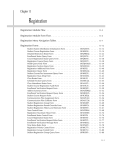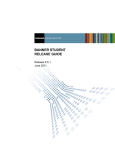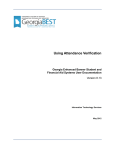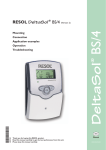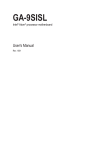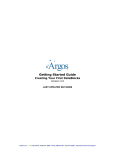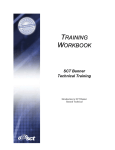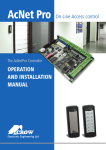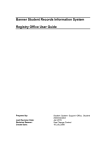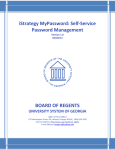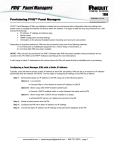Download Fee Assessment Migration FAQs from SCT for 5.6
Transcript
SCT FAQs re Fee Assessment Compiled by OIIT SCT FAQs for Fee Assessment Enhancements Introduction Purpose and Scope of Document SCT has provided instructions for migration to the new registration fee assessment processing in Student 5.6 and 6.0 in the form of FAQs. OIIT has assembled those FAQs from the Action Web for your reference. Instructions have not been edited or reformatted. Included are answers to the following questions: 11504 How do we migrate to the new registration fee assessment processing in Student 5.6 or 6.0? 11505 What does a 'refund by total' institution need to know before migrating to the new registration fee assessment? 11506 How does "Refund by Total" work? 11507 What is "refund by enrollment status" and how does it work? 11508 How is my current 'plateau' rule set up impacted by the enhanced rule design for registration fee assessment? 11625 If a plateau was used in the previous version of fee assessment, but plateau credits were not entered (left null) how do I build the SFARGFE rules in the 5.6/6.X version? Target Audience Technical Support Staff and Functional Users Prequisite Patches The following patches must be applied bfore migration and testing: 5.6.0.1 Fee Assessment patches 87325 SFKFEES, SFKFEE1 which also contains 87305, 87360, 87611, 87678, 87516, 87662 87516 SFRFASC which also contains 87251, 87896 87856 SFAREGS November 2003 Page 1 SCT FAQs re Fee Assessment Compiled by OIIT 5.6.0.2 Fee Assessment patches 76841 SFKFEES, SFKFEE1 which also contains 88025, 82332, 85027, 85041, 85644, 86543, 87601, 84615, 87140, 57680, 88193 Note: SCT’s FAQ 11504 online refers to patch 88025, which includes defect correction 76841. The correct patch number is 76841, which includes defect correction 88025. 5.6.0.3 Fee Assessment patches 88291 SFKFEES, SFKFEE1 which also contains 88676, 88326, 88708, 87903, 88382 88342 SFAREGF which also contains 88518, 87675 88736 SFRFASC Best Practice You are strongly urged to apply this release to your test environment before applying it to production. Additional References In addition to these FAQs from the SCT Action Web at www.sct.com, you should read the Student 5.6 Release guide before applying and converting to the new fee assessment process. Support Reuest support by contacting OIIT Customer Services in one of the following ways: • Web http://www.usg.edu/customer_services • Toll-free phone 1-888-875-3697 • E-mail [email protected] FAQ 11504: How do we migrate to the new registration fee assessment processing in Student 5.6 or 6.0? To migrate to the new registration fee assessment processing, read the following important, related information and follow the migration steps listed below. It is extremely important that clients recognize that the registration fee assessment area of the Banner Student product has been completely reengineered and rewritten. SCT would like to stress to all clients the importance of consulting and following the guidelines provided in the release documentation and FAQ pages. SCT recognizes that all institutions are unique and that implementations differ from institution to institution. It is essential that these guidelines are followed and that, as with any release, Student 5.6 or Student 6.0 are tested appropriately in a test environment that is a recent copy of your production database to ensure no institution specific variables could pose risk of introducing data corruption. If you are a refund by total institution, please refer to and read FAQ 11505 "What does a refund November 2003 Page 2 SCT FAQs re Fee Assessment Compiled by OIIT by total institution need to know before migrating to the new registration fee assessment?" before product installation and migration to the new processing. Please also refer to and read FAQ 11506 "How does refund by total work?" for an explanation of how refund by total works in the new assessment processing. If you are a institution who uses 'plateaus', please refer to and read FAQ 11508 "How is the current plateau rule set up impacted by the enhanced rule design?" before product installation and migration to the new processing. There is also no longer a need to enter negative rules to 'back out' extra charges when institutions used 'plateaus' rules or rules to perform overload charging. These rules can stay in place when migrating terms that are in-progress and the correct assessment results will be yielded. However, these rules can be set up for new terms to yield the correct results without needing to create negative rules due to the enhanced rule design. Please refer to the Student 5.6 Release Guide or the Student 6.0 User Guide under "NEW ASSESSMENT PROCESS, Registration Fee Assessment Rules" for a more detailed explanation of the rule enhancements. SCT recommends that registration fee assessment rules other than the previous 'plateau' rules not be changed when migrating to the new assessment processing for terms that are in-progress. Due to the dependency on 5.5 registration fee assessment to be current prior to upgrading to Student 5.6 or 6.0, database administrators and user staff performing the migration steps need to be in communication while performing the upgrade. Database administrators cannot install the Student 5.6 or 6.0 upgrade until the database (the clone of production as well as production) is current with 5.5 assessment. The following are the migration steps to follow: 1. Thoroughly read the Student 5.6 Release Guide or the Student 6.0 User Guide 2. Clone your production database to a test instance/environment. 3. Become current with registration fee assessment using SFRFASM or SFRFAS1 in your test instance. A. PLEASE NOTE: SFRFASM and SFRFAS1 are obsolete after upgrading to Student 5.6 or 6.0. It is imperative that SFRFASM or SFRFAS1 be run PRIOR to upgrading to Student 5.6 or 6.0 as the source code will not be available after the upgrade and clients will not have an opportunity to become current using the 5.5 assessment code. B. PLEASE NOTE: In order to 'become current' with old fee assessment, there are two options: The first is to delete all records for the term being processed from the SFRBTCH collector table, then run SFRFASM or SFRFAS1 in ALL mode; the second is to run SFRFASM or SFRFAS1 in COLLECTOR mode, then run it again in ALL mode. Either of these options will ensure that all students are processed and current for that term. 4. Install Student 5.6 or 6.0. 5. Review/scrutinize assessment rules: A. Print report of rules with negative charges: srefrgfe.sql November 2003 Page 3 SCT FAQs re Fee Assessment Compiled by OIIT i) Negative rules are no longer needed when using plateau and overload rules in the new design, but assessment processing will yield the correct results with the negative rules in place. ii) SCT recommends that registration assessment rules other than the previous 'plateau' rules not be changed when migrating to the new assessment processing for terms that are in-progress. iii) Clients have an opportunity to redefine rules for new terms to take advantage of the rule enhancements made as of Student 5.6. Please refer to Student 5.6 User Guide for further information about the rule enhancements. B. Institutions using plateaus will need to update their rules by entering the "to flat hours" value to define the ending point of the flat hour range. i) Please refer to and read FAQ 11508 "How is my current 'plateau' rule set up impacted by the enhanced rule design for registration fee assessment?" ii) Previous 'plateau hours' are copied to new 'from flat hours' field viewed in the SFARGFE screen as part of the product installation. iii) Product installation does not default a value for new 'to flat hours' field as seen in the SFARGFE screen; institutions must enter this value to define their flat hour range. iv) The new "flat charge amount" will need to be entered using the SFARGFE screen and the per credit charges reset to 0, unless using overload processing (please see documentation). v) These data modifications allow the flat hour charge processing and the recording of the data as such in the audit history. C. Institutions using refund by total will need to review the refund rules viewed in the SFARFND screen. i) Please refer to and read FAQ 11505 "What does a refund by total institution need to know before migrating the new registration fee assessment?" ii) Detail code specification is no longer required in these rules. iii) The GTVSDAX entry FAUSECLRDL (use clearing accounts) has been removed as part of the Student 5.6 and 6.0 upgrades via the sdelsdax1.sql script. iv) The existence of a detail code in the rules indicates the use of clearing accounts for the penalty posting. If detail codes are not specified, the penalty will post to the detail code of the original charge. 6. Run SFRFASC in test instance to perform the migration step of creating audit history records for the term being tested. A. There is a hook in registration to perform this step if registration is being updated for a student who has already been assessed for the term, but does not have audit history records for the term. For purposes of testing, SFRFASC will be run to perform this step. B. Regardless of the hook in registration, the migration step performed using SFRFASC (step 6) is REQUIRED for refund by total institutions due to the need of the process to refer to the audit data of the last assessment. The migration step performed using SFRFASC (step 6) is also REQUIRED if you have run prebill assessment for the processing term prior to upgrading, regardless of whether you use refund by total or refund by course. i) Please refer to and read FAQ 11505 "What does a refund by total institution need to know before migrating to the new registration fee assessment?" and FAQ 11506 "How does refund by total work?" C. In the test instance, for the purposes of testing, perform this step for all students within the term being tested using the SFRFASC parameters listed below. D. Refund by total institutions need to be aware of the new job parameter for the 'refund by total refund date'. This date determines the refund interim to use for the run. November 2003 Page 4 SCT FAQs re Fee Assessment Compiled by OIIT i) If a refund interim is appropriate for the term being tested, specify a date that is within the desired refund interim. If a refund is inappropriate, leave the parameter blank to prevent refunds and penalties from being processed. E. Parameters to enter for SFRFASC: i) Parm 1: Term: Enter term being tested. ii) Parm 2: Assessment date: Enter effective date for term being tested. If left blank the process will determine a valid effective date to use. iii) Parm 8: Batch type set to 'E' for 'by enrollment status' iv) Parm 9: Enrollment status set to '%' v) Parm 10: Full or part time indicator set to '%' vi) Parm 11: Assessment rule type set to 'R' for 'regular' or 'P' for 'prebill' vii) Parm 12: Accounting detail to print set to 'N' for 'none' viii) Parm 13: Report type of 'A' for 'audit' ix) Parm 17: Create accounting records set to 'N' for 'no' x) Parm 18: If refund by total, specify refund by total refund date (1) Determines the desired refund interim to have in effect for the run (2) Leave blank if no refunds/penalties processed for term xi) Parm 19: run mode set to 'U' for 'update' 7. Perform a controlled comparison of the results of the newly created assessment audit history detail to student accounting data existing in the database for a select set of student IDS. 8. Run SFRFASC to perform an actual assessment in audit mode to unveil any assessment anomalies. A. ANY detail in this report needs to be treated as an anomaly and reviewed. B. Client can use either a controlled method of assessing (by ID, enrollment status with specific STVESTS code, popsel) or can perform a full run by enrollment status for all STVESTS codes. i) Clients will want to compare the results of the determined accounting charges for this run to what exists in student accounting C. The following steps are for performing a full run in audit mode. For purposes of testing, this method is recommended. Parameters to enter for SFRFASC: i) Parm 1: Term: Enter term being tested. ii) Parm 2: Assessment date: Enter effective date for term being tested. If left blank the process will determine a valid effective date to use. iii) Parm 8: Batch type set to 'E' for 'by enrollment status' iv) Parm 9: Enrollment status set to '%' v) Parm 10: Full or part time indicator set to '%' vi) Parm 11: Assessment rule type set to 'R' for 'regular' or 'P' for 'prebill' vii) Parm 12: Accounting detail to print set to 'C' for 'current' viii) Parm 13: Report type of 'T' for 'accounting' (TBRACCD) records ix) Parm 17: Create accounting records set to 'Y' for 'yes' x) Parm 18: If refund by total, specify refund by total refund date (1) Determines the desired refund interim to have in effect for the run (2) Leave blank if no refunds/penalties processed for term xi) Parm 19: run mode set to 'A' for audit November 2003 Page 5 SCT FAQs re Fee Assessment Compiled by OIIT 9. After resolving any anomalies that may have arisen during testing, perform in-house test cases to verify registration fee assessment yields the correct results. A. Update registration records and perform assessments either on-line or by using SFRFASC. 10. After all testing in the test instance is complete and verified, perform Student 5.6 or Student 6.0 upgrade in production by following the steps 1-8 listed above, with the exception of step 6 (run the new batch assessment process SFRFASC to perform the migration step of creating the audit history records) which only needs to be run by institutions using refund by total. A. Please refer to and read FAQ 11505 "What does a refund by total institution need to know before migrating to the new registration fee assessment?" and FAQ 11506 "How does refund by total work?" B. The migration step (step 6 above) is not required by institutions not using refunding by total since registration processing was updated to create the audit history records automatically if the student updating their registration has had an assessment run for the term but does not have any audit history records for the term. ********************************************************* 5.6.0.1 Fee Assessment patches were posted on 24-JUN-2003. Please make sure to download and apply these patches prior to doing any fee assessment migration or testing. The patch numbers are: 87325 SFKFEES, SFKFEE1 which also contains 87305, 87360, 87611, 87678, 87516, 87662 87516 SFRFASC which also contains 87251, 87896 87856 SFAREGS ********************************************************* 5.6.0.2 Fee Assessment patches were posted on 19-JUL-2003. Please make sure to download and apply these patches prior to doing any fee assessment migration or testing. The patch number is: 88025 SFKFEES, SFKFEE1 which also contains 76841, 82332, 85027, 85041, 85644, 86543, 87601, 84615, 87140, 57680, 88193 Note from OIIT: SCT’s FAQ 11504 online refers to patch 88025, which includes defect correction 76841. The correct patch number is 76841, which includes defect correction 88025. ********************************************************* 5.6.0.3 Fee Assessment patches were posted on 18-AUG-2003. Please make sure to download and apply these patches prior to doing any fee assessment migration or testing. November 2003 Page 6 SCT FAQs re Fee Assessment Compiled by OIIT The patch numbers are: 88291 SFKFEES, SFKFEE1 which also contains 88676, 88326, 88708, 87903, 88382 88342 SFAREGF which also contains 88518, 87675 88736 SFRFASC ********************************************************* FAQ 11505: What does a 'refund by total' institution need to know before migrating to the new registration fee assessment? Refund by total institutions need to know about: 1) The migration processing using the new batch process SFRFASC to populate the new assessment audit history table viewed in the SFAFAUD screen. 2) The new 'refund by total refund date' parameter in the new batch assessment process SFRFASC. 3) The need for clients to remove detail codes that are not clearing accounts from the refund rules defined in the SFARFND screen (entry of the clearing account detail codes is now optional). 4) The clean up of the 0% or 100% refund rules in screens SFARSTS or SFAESTS by clients. 5) SCT removal of the GTVSDAX entry for FAUSECLRDL. It is extremely important that clients recognize that the registration fee assessment area of the Banner Student product has been completely reengineered and rewritten. SCT would like to stress to all clients the importance of consulting and following the guidelines provided in the release documentation and FAQ pages. SCT recognizes that all institutions are unique and that implementations differ from institution to institution. It is essential that these guidelines are followed and that, as with any release, Student 5.6 or Student 6.0 are tested appropriately in a test environment that is a recent copy of your production database to ensure no institution specific variables could pose risk of introducing data corruption. Item 1: Migration processing to populate the new audit history table viewed in the SFAFAUD screen using the new batch process SFRFASC. Please refer to and read FAQ 11504 "How do we migrate to the new fee assessment processing in Student 5.6 or 6.0?" for the steps to follow to migrate to the new registration fee assessment processing. Institutions who use refund by total will need to perform a migration step to build audit records for the previous assessments already recorded in the database using the new batch process SFRFASC. This processing will not build any student accounting records. November 2003 Page 7 SCT FAQs re Fee Assessment Compiled by OIIT As part of the refund by total processing, the audit data is consulted to determine the liable amounts for the last assessment for comparison to the liable amounts for the current assessment. Performing this step will create the assessment audit history snapshot of the last assessment. When running SFRFASC, the desired refund date must be specified for the new 'refund by total refund date' parameter. This is to ensure that the correct refund interim is used in the processing and that the correct liable amounts, reassessment credit and penalty are determined and stored in the new assessment audit history table. If the last set of processing performed for the refund by total term did not involve a refund interim, simply do not specify a date in the new 'refund by total refund date' parameter. Please refer to FAQ 11506 "How does refund by total work?" for more detail on the refund by total processing. SFRFASC parameters: Parm 1: Term: Enter term being tested. Parm 2: Assessment date: Enter effective date for term being tested. If left blank the process will determine a valid effective date to use. Parm 8: Batch type set to 'E' for 'by enrollment status' Parm 9: Enrollment status set to '%' Parm 10: Full or part time indicator set to '%' Parm 11: Assessment rule type set to 'R' for 'regular' or 'P' for 'prebill' Parm 12: Accounting detail to print set to 'N' for 'none' Parm 13: Report type of 'A' for 'audit' Parm 17: Create accounting records set to 'N' for 'no' Parm 18: If refund by total, specify refund by total refund date Determines the desired refund interim to have in effect for the run Leave blank if no refunds/penalties processed for term Parm 19: run mode set to 'U' for 'update' Item #2: The new 'refund by total refund date' parameter in the new batch assessment process SFRFASC. The previous version of the batch fee assessment code utilized a single date parameter that controlled both the assessment effective date and the refund by total refund date. There are now two date parameters in the new assessment process SFRFASC: the assessment effective date and the refund by total refund date. These two dates are not related to each other in the processing. This design provides better date control for the assessment and refund by total processing. If reassessment credits/penalties are to be processed for the assessment, the value of the refund by total refund date should be a date that is within the desired defined refund interim for the term for the run. The date entered in this parameter determines the 'refund' interim chosen for the run and also serves as the effective date to use in student accounting for the both the reassessment credit and the penalty. The refund interims by term are maintained via the SFARFND screen. November 2003 Page 8 SCT FAQs re Fee Assessment Compiled by OIIT If reassessment credit/penalties are not to be processed during the run, simply leave the refund by total refund date blank. Leaving this date blank will only prevent the processing of the reassessment credits and penalties and has no bearing on any newly determined assessment charges during the run. New charges will post to student accounting using the validated assessment effective date specified for the run. Item #3: The need for clients to remove detail codes that are not clearing accounts from the refund rules defined in the SFARFND screen. As of Student 5.6, the entry of the clearing account detail codes is optional in the refund by total refund definition screen SFARFND. The existence of detail codes in the refund definition records is now indicative that clearing accounts are in effect. Any determined penalty by DCAT code of TUI or FEE in the refund by total processing will post to the appropriate clearing account detail code defined in the refund record. The absence of detail codes in the refund record definition indicates that any determined penalty by DCAT code of TUI or FEE in the refund by total processing needs to post to the detail code of the original charge. If in the previous assessment processing your site had the GTVSDAX entry labeled FAUSCLRDL (use clearing account) set to 'N', the detail codes entered in the SFARFND screen will need to be deleted. If these detail codes remain intact in the refund definition, the penalties will post to those specified detail codes. Item #4: Clean up of the 0% or 100% refund rule in screens SFARSTS or SFAESTS. As of Student 5.6, there is no longer a need for the 0% or 100% refund rules defined in screens SFARSTS or SFAESTS solely to permit the refund by total processing to work. The refund rules defined in the SFARFND screen are the only rules utilized in the new refund by total processing. Item #5: SCT removal of the GTVSDAX entry FAUSECLRDL. As of Student 5.6, the GTVSDAX entry for FAUSECLRDL (use clearing accounts) is obsolete and is purged from the GTVSDAX table, as it is not referenced in the new registration fee assessment code. The script sdelsdax1.sql performs this task as part of the upgrade processing. The determination and use of clearing account detail codes is explained in item #3 above. FAQ 11506: How does "Refund by Total" work? Refund by total allows an institution to charge, process reassessment credits, and penalize students based solely on the hours in which they are registered. Hours for courses that the student has dropped are not included. November 2003 Page 9 SCT FAQs re Fee Assessment Compiled by OIIT The phrase "refund by total" would be more accurately stated as "penalty processing". In refund by total, the student is 100% liable for the bill hours of the courses that they are registered in (STVRSTS_WD_IND <> Y) and they are 100% liable for 0 bill hours of the courses that they have dropped (STVRSTS_WD_IND = Y). The 'refund' definition found in the SFARFND screen is really used to determine the penalty percentage. There are no 'refund' percentages per se. The penalty percentage is the compliment of the defined refund percentage, which is determined by subtracting the refund percentage from 100. Additionally, clearing accounts can optionally be specified using the SFARFND screen. The existence of a detail code in the refund definition record now signifies that the penalty needs to post to a clearing account. If no detail code is specified in the refund definition, the penalty will post to the detail code of the original charge. The refund by total processing works as follows: The liable bill hours for the registered courses are determined and the rule processing is invoked for the hours that the student is registered in (course that they have not dropped). The amount that the student is liable for as of the current assessment is determined for each detail code using the assessment audit data. The amount for each detail code is then compared to what the student has already been charged for in student accounting. If the amount that the student has already been charged for in student accounting is greater than the current liable amount in the assessment audit data, the 'refund by total' processing is invoked. The liable amount for each detail code in the previous assessment is determined using the assessment audit history data. The reassessment credit is determined by subtracting the current assessment liable amount from the previous assessment liable amount. These liable amounts come from the assessment audit history data. Again, note that the refund percentage definition does not come into play here at all. The reassessment credit will then post to the detail code of the original charge. The penalty is then determined by applying the penalty percentage (the determined compliment to the refund percentage definition) to the reassessment credit amount just determined. If clearing accounts are specified in the refund definition rule, the penalty will post to the clearing account. If no detail code is specified in the refund definition rule, the penalty will post to the detail code of the original charge FAQ 11507: What is "refund by enrollment status" and how does it work? Refunding by enrollment status allows refunding to occur for a student's total liable bill hours based on enrollment status codes. November 2003 Page 10 SCT FAQs re Fee Assessment Compiled by OIIT Enrollment status codes can 'cascade' down to the course status codes based on control settings that can be defined within registration. When a student withdraws from an institution by having his enrollment status updated to a code that indicates withdrawal, courses updated to have the same status code and date as the enrollment status (occurring due to the defined control settings) will have the refund percentages for the enrollment status applied to them. It is extremely important that clients recognize that the registration fee assessment area of the Banner Student product has been completely reengineered and rewritten. SCT would like to stress to all clients the importance of consulting and following the guidelines provided in the release documentation and FAQ pages. SCT recognizes that all institutions are unique and that implementations differ from institution to institution. It is essential that these guidelines are followed and that, as with any release, Student 5.6 or Student 6.0 are tested appropriately in a test environment that is a recent copy of your production database to ensure no institution specific variables could pose risk of introducing data corruption. Student status codes can be set up to affect/override course status codes. Please refer to your Banner Student User Manual for further detail on defining registration and student status codes. The assumption coming into fee assessment is that any registration status codes that the institution wishes to be updated by any changed enrollment status codes will be set up accordingly using the controls available in the SFARSTS screen (Course Registration Status). Refund by enrollment status will only be executed for terms not flagged for refund by total processing. The assessment processing for refunding by enrollment status works as follows: If refund by total is not in effect for the term, the enrollment status code is checked to see if it signifies a withdrawal (STVESTS_WD_IND = Y). If the enrollment status does indicate a withdrawal, the refund percentages are determined for the ESTS code and date. If an enrollment status refund rule is found, all registration records updated to have the same course registration status code and date as the enrollment status code and date will be determined and the enrollment status refund will be applied to those courses up front to determine the student's liability for the course. The process marks that the course was processed to have the enrollment status refund applied. After these courses have been processed, the courses outside of those having the same status code and date are determined. If an enrollment status refund was defined and was not applied to a course, the enrollment status refund is then applied to the course. If no enrollment status refund rule is found, assessment will continue by processing the registration records using conventional course refunding based on registration status code and date. November 2003 Page 11 SCT FAQs re Fee Assessment Compiled by OIIT FAQ 11508: How is my current 'plateau' rule set up impacted by the enhanced rule design for registration fee assessment? Institutions using the previous 'plateau' design need to enter an ending value for the new 'to flat hours' field in the new flat hour range that exists in the enhanced rule definition in the SFARGFE screen. They will also need to scrutinize their preexisting values for the 'plateau hours' defined in the SFARGFE screen. Institutions who had flat charges but did not "refund with plateaus" must leave all the hours information and min/max entries on rules as set up in the previous versions of fee assessment. In this case, refunds will be based on straight liability hours and will not look for the "plateau" point from which to calculate refunds. It is extremely important that clients recognize that the registration fee assessment area of the Banner Student product has been completely reengineered and rewritten. SCT would like to stress to all clients the importance of consulting and following the guidelines provided in the release documentation and FAQ pages. SCT recognizes that all institutions are unique and that implementations differ from institution to institution. It is essential that these guidelines are followed and that, as with any release, Student 5.6 or Student 6.0 are tested appropriately in a test environment that is a recent copy of your production database to ensure no institution specific variables could pose risk of introducing data corruption. The previous rule design did not allow the definition of true flat hour ranges, which was the purpose of the 'plateau' idea. The enhanced rule definition now includes the ability to define a true flat hour range as well as a true flat charge amount. This information is now accessible to the fee assessment process for determining the correct calculation for dropping in and out of the flat hour range, honoring the previous "plateau" or the current from flat hours. After installing either version Student 5.6 or Student 6.0, any institution using the previous 'plateau' design will need to review and scrutinize their rules using the SFARGFE screen. As part of the upgrade, a script is executed that copies the previous 'plateau hours' to the new 'from flat hours'. The value entered for these hours is the first thing that will need to be scrutinized. The preexisting value copied from the plateau hours to the new 'from flat hours' may need to be updated. In the previous rule design, the value entered in the 'plateau hours' was sometimes a value that was arrived at through trial and error. In some cases, the plateau hour value would be extended to specific decimal values (e.g., 12.0175) to yield correct refunds when using plateaus. In the new assessment processing, these extended decimal values are not needed. For example, if an institution's flat hour range is 12-18 hours, the value of 12.00 would be entered for the 'from flat hours' and the value of 18.00 would be entered for the 'to flat hours'. Next, institutions will need to enter a value for the new 'to flat hours' in the SFARGFE screen, which will be the ending hours for the flat hour range. A value is not defaulted in for these hours as part of the upgrade processing. November 2003 Page 12 SCT FAQs re Fee Assessment Compiled by OIIT Lastly, institutions must record the value of the flat fee charge amount in the new 'flat charge amount' field in the SFARGFE screen. This amount was typically entered as the min/max amount for the rule in the previous rule design. If the flat hour rule does not additionally need to define overload charges as part of the rule, the per credit charges need to be reset to zero at this time as well. Please refer to the Student 5.6 Release Guide for further detail on the flat and overload rule set up. By performing these three steps, the rules become defined as a flat charge amount rule and will be recorded as such in the assessment audit history data viewed in the SFAFAUD screen. FAQ 11625: If a plateau was used in the previous version of fee assessment, but plateau credits were not entered (left null) how do I build the SFARGFE rules in the 5.6/6.X version? : In the previous version of fee assessment, when per credit charges (0.01 to 11.99 credit range, for example) and a flat fee (12.00 and above) existed, a plateau indicator was used to identify this setup. If plateau hours were entered, then the refunding process used the plateau hours when calculating a refund. If plateau hours were not listed, the actual original credit hours were used for refunding. With the new fee assessment (5.6, 6.0), refunding calculations use the From Flat Hours value in place of Plateau Hours. Therefore, if a school would like refunding calculations to use the actual hours of registration as opposed to the From Flat Hours value, the following setup must be used. Example In this case, we've chosen to differentiate between part-time, full-time and overage charges so three different detail codes are used; however, except for the detail codes, the rules would be the same if fewer detail codes were needed. One detail code is used to record charges for part-time (0.01 to 11.99 credits) students, a second for full-time, flat rate (12.00 to 18.00 credits) students and a third for "overage" (18.01 and over) credits. $100 per credit is charged for 0.01 to 11.99 credits. A flat rate of $1,200 is charged if someone is taking from 12.00 to 18.00 credits. If a student is taking more than 18.00 credits, an additional $100 per credit is assessed. Please note that a Rule Type of Student was used in the following two examples. Per Liable Liable Flat Flat Detl Cred Minim Max Hours Hours Hours Hours Flat Code Chrg Chrg Chrg From To From To Amount TPRT 100 0 1200 0.01 11.99 TFLL 0 1200 1200 12.00 99.00 November 2003 Page 13 SCT FAQs re Fee Assessment Compiled by OIIT TOVR 100 0 9999 18.01 99.00 TOVR 0 -1800 -1800 18.01 99.00 In this setup, if a student registers for 15 credits and then drops all 15 in a 50% refund period, the revised calculation of charges will be based on the change from 15 hours to 0 hours. The calculation will result in a liability of 7.5 (50% of 15) hours and the student will be charged $750. In this example, the TFLL detail code will show a $1200 reversal as the student no longer qualifies for that rule. The new charge of $750.00 will be applied to the detail code of TPRT since this is now the rule that applies to 7.5 hours. The credit to the student's account will be $450.00. If another student is registered for 16 credits and then drops all hours in a 50% refund period, the refund will be based upon the change from 16 to 0 hours. The new assessment will be based on 8 hours (50% of 16) and the student's new charge will be $800.00. The TFLL detail code will again show a $1200 reversal, but a new charge of $800.00 will be applied to the detail code of TPRT. This student will have a 400.00 credit. -------As an example of how this differs from the use of Flat Hours, the following setup is comparable to the rules listed above with the exception of the entry of Flat Hours and a Flat Amount. Per Liable Liable Flat Flat Detl Cred Minim Max Hours Hours Hours Hours Flat Code Chrg Chrg Chrg From To From To Amount TPRT 100 0 1200 0.01 11.99 TFLL 0 1200 1200 12.00 99.00 12.00 99.00 1200 TOVR 100 0 9999 18.01 99.00 TOVR 0 -1800 -1800 18.01 99.00 In this case, and this is the primary difference from the previous one, refunds will treat a student who drops below 12 hours as if s/he had 12 beginning liable hours (Flat Hours From) prior to the change. This is comparable to what was plateau refunding (Plateau Hours entered) in the previous versions of fee assessment. Using these rules, a student who drops from 14 hours to 9 hours in a 50% refund period will receive the same refund as a student who drops from 15 hours to 9 hours in the 50% refund period. This occurs since, in each case, the recalculation of charges uses 12 beginning liable hours as opposed to 14 or 15. There will be a reversal of the TFLL detail code charge of $1200. A new charge or $1050 using the TPRT rule and detail code will be assessed. The refund to both students will be $150. November 2003 Page 14














